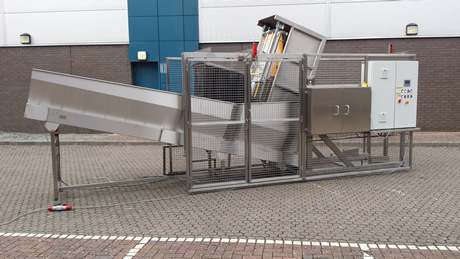Mechanized unloading
Manually unloading parcels from transportation containers onto an automated parcel sortation system is highly labor intensive and can be a risk to the health and safety of employees. It is also an inefficient, highly repetitive task that can become a bottleneck in any sortation process. In addition, many of the transportation containers used in the mail industry are not ideal for manual handling, requiring low bending for items at the bottom of the container, as well as continuous repetition of the lifting and twisting operation.

To solve these issues Base Handling Products, together with one of the world’s leading mail processing companies, has developed a fully mechanized mail container tipper. The solution efficiently handles high volumes and eliminates manual handling risks, yet is easy to set up and operate. It is also CE certified, complying with all EU legislation.
A standard mail induction process uses six manual mail handlers to unload at a rate of 20 containers per hour. The new solution, utilizing two tippers, uses two operators to mechanically unload at a rate of 80 containers per hour.
The Base Handling mechanized solution has now tipped over two million mail containers with an average of 130 parcels per container, which amounts to over a 250 million parcels that have not been handled manually. Ongoing development has seen a reduction in the total tipping cycle to 36 seconds, allowing a single machine to tip over 60 containers per hour.
The system uses a lifting carriage that the container is wheeled onto, enclosed within a safety guard with a Performance D Category Safety Circuit. Once the container is loaded and detected, the guard gate is closed and the container lifted, tipping the mail onto a conveyor at a height of 1m with a maximum tip angle of 180°. Safety features ensure that the caged area is not entered during operation of the machine and that the cage door is securely locked.
The mail container is securely retained in the lift carriage until it is returned safely to its starting position. The whole tipping cycle is fully automated with features that adjust the speed and angle, with a pause option too. Designed with operation, reliability and ease of maintenance in mind, an electronic counter warns the operator of a pending inspection requirement, based on the number of machine operations.



